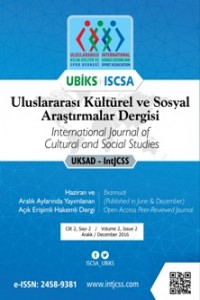Abstract
Bilim ve teknoloji her geçen gün
hızla değişmekte ve etrafımızdaki imgeleri etkilemektedir. Hareketli
görüntüler, filmler ve videolar kişisel taşınabilir aygıtların yaygınlaşması
ile günlük hayatta çok daha fazla yer almaya başlamıştır. Hareketli imgelerin
kullanım yoğunluğunun artması tasarım kültürünü de etkilemekte ve doğal olarak
üretim ve uygulama yapan tasarımcı ihtiyacını oluşturmaktadır. Çağa ayak
uyduran ve üretken bir eğitim verebilmek için görsel sanat ve grafik tasarım
eğitiminin de teknolojik olanakları dikkate alarak güncel kalması ve bu
ihtiyacı karşılaması gerekmektedir. Bu bildiride bir atölye dersi olan Video
Kurgu’da dersinin öğretimindeki süreçler anlatılmaktadır. Çalışılan uygulamanın
konusu HÜ GSF bünyesinde açılan Özgün Baskı: Serigrafi dersi eğitim
videolarıdır. Uygulamanın ana amacı uygulayanlar açısından öğrencilerin video
montaj tekniklerini, çekim yöntemleri ve kamera kullanımını, çekim yapılacak
fiziksel ortamı düzenlemenin uygulama sürecinde öğretilmesidir. Bir diğer amaç
ise üretilen çevrimiçi eğitim videoları ile ilgili dersin anlaşılabilirliğini
artırmak ve uzaktan eğitim gibi yeni teknolojilerin sağladığı olanaklardan
yararlanarak güzel sanatlar alanındaki klasik atölye eğitimini
zenginleştirmektir. Video ve hareketli grafikler sürekli gelişen ve değişimin
odağında olan bir medyum olduğundan dolayı uygulamanın yöntemi deneysel bir
yaklaşımla konuyu, öğrencilerin ilgisi, kullanılacak aygıtlar ve mekân
koşulları dikkate alınarak aktif öğrenme, problem temelli öğrenme ve akış
kuramlarından sentezlenmiştir. Videoda anlatım biçemi olarak belgesel dili
tercih edilmiştir. Teknik altyapıda ise kullanılan aygıtlara ve yazılımlara
değinilmiştir. Uygulamanın aşamaları haftalara bölünerek yapılan çalışmalar
özetlenmiştir. Son aşama olan montaj süreçlerinden sonra videolar çevrimiçi ağa
yüklenerek öğrencilerin üniversite dışında da bu dersi tekrarlamaları
amaçlanmış ve içerik olarak değinilen konunun akılda kalıcı olması sağlanmak
istenmiştir. Sanat ve tasarım alanında nitelikli bireyler yetiştirilmesi;
yaratıcılığın ön plana çıkarılması, öğretme ve öğrenmenin öğrenci merkezli
olması, atölye sürecinde uygulanacak yöntemlerin çağdaş bir anlayışla zamanın
gerekliliklerine uygun biçimde tasarlanması, uygulanması, değerlendirilmesi ve
geliştirilmesi ile mümkün olacaktır. Bu çalışma grafik tasarımcıların görsel
iletişimdeki son yıllarda gerçekleşen gelişmelerden doğan beklentileri
karşılayacak üretimlerde bulunmalarını ve yaratıcılıklarını kullanmalarını
sağlayacak şekilde nasıl yetiştirilmeleri gerektiğini ortaya koymaktadır.
References
- Anderson, M. (2009). Teaching the Screen. Allen & Unwin: Australia
- Arıjon, D. (1995). Film Dilinin Grameri I, Çev Ed: Yalçın Demir, Kavram Yayınları: İstanbul
- Cereci, S. (1997). Belgesel Film. Şule Yayınları: İstanbul
- Demirel, Ö. (2002). Planlamadan Değerlendirmeye Öğretme Sanatı. Pegem Yayıncılık: İstanbul
- Shernoff, D. vd. (2003). Student Engagement in High School Classrooms in Terms of Flow Theory. School Psychology Quarterly. Vol. 18 No:2
- Wıllıams, R. (1993). Kültür, Çev. Suavi Aydın, İmge Kitabevi: Ankara
Abstract
Science and technology are changing rapidly
with each passing day and affect the images around us. Motion images, movies,
and videos have begun to take much more space in daily life along with the
widespread use of personal portable devices. The increase in the intensity of
using motion images also affects the design culture and naturally leads to the
need for designers performing production and application. Visual art and
graphic design training should stay up to date by taking into account the
technological opportunities and should meet this requirement to provide a
modern and productive training. In this paper, the processes in the teaching
of the course of Video production, a studio classroom course, are explained.
The subject of the studied practice is the Individual Press : Silkscreen course
training videos opened within Hacettepe University Faculty of fine Arts. The
main purpose of the application is to teach video editing techniques, shooting
techniques and the use of cameras, the arrangement of the physical environment
to be shot in the implementation process to students in terms of practitioners.
Another purpose is to increase the intelligibility of the relevant course along
with the online training videos produced and to enrich the classical studio
classroom training in the field of fine arts by taking advantage of the
opportunities offered by new technologies such as distance learning. Since
video and motion graphics are the media which are constantly developing and at
the focus of change, the method of application was synthesized from active learning,
problem-based learning and flow theories with an experimental approach by
taking into account the subject, students' interest, instruments to be used and
the space conditions. The documentary language was preferred as a form of
expression in the video. The instruments and software used were mentioned in
the technical infrastructure. The studies performed were summarized by dividing
the stages of the application into weeks. After the montage processes which are
the final stage, students were aimed to repeat the course outside the
university by uploading videos to the online network, and it was aimed to
ensure the memorability of the subject mentioned in terms of content. Training qualified individuals in the field
of art and design will be possible by bringing creativity to the forefront, the
fact that teaching and learning are student centered and by designing,
implementing, evaluating and improving the methods to be applied in the studio
classroom process with a contemporary approach in accordance with the
requirements of the time. This study reveals that graphic designers need to
engage in production to meet the expectations arising from the developments
occurred in recent years in visual communication and that how they need to be
trained to allow them to use their creativity.
References
- Anderson, M. (2009). Teaching the Screen. Allen & Unwin: Australia
- Arıjon, D. (1995). Film Dilinin Grameri I, Çev Ed: Yalçın Demir, Kavram Yayınları: İstanbul
- Cereci, S. (1997). Belgesel Film. Şule Yayınları: İstanbul
- Demirel, Ö. (2002). Planlamadan Değerlendirmeye Öğretme Sanatı. Pegem Yayıncılık: İstanbul
- Shernoff, D. vd. (2003). Student Engagement in High School Classrooms in Terms of Flow Theory. School Psychology Quarterly. Vol. 18 No:2
- Wıllıams, R. (1993). Kültür, Çev. Suavi Aydın, İmge Kitabevi: Ankara
Details
| Journal Section | Review |
|---|---|
| Authors | |
| Publication Date | December 30, 2016 |
| Submission Date | August 30, 2017 |
| Acceptance Date | November 25, 2016 |
| Published in Issue | Year 2016 Volume: 2 Issue: 2 |
International Journal of Cultural and Social Studies

